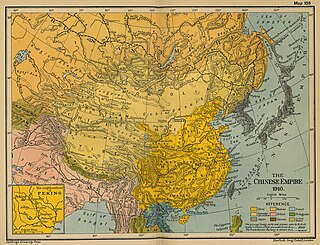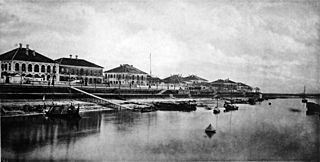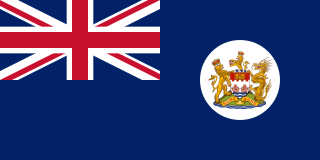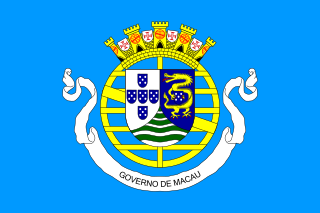 W
WConcessions in China were a group of concessions that existed during the late Imperial China and the Republic of China, which were governed and occupied by foreign powers, and are frequently associated with colonialism and imperialism.
 W
WTreaty ports were the port cities in China and Japan that were opened to foreign trade mainly by the unequal treaties forced upon them by Western powers, as well as cities in Korea opened up similarly by the Japanese Empire.
 W
WThe American Concession or Settlement was a foreign enclave in Shanghai within the Qing Empire which existed from around 1848 until its unification with the city's British area to form the Shanghai International Settlement in 1863.
 W
WThe Austro-Hungarian concession of Tianjin was a territory (concession) in the Chinese city of Tientsin occupied colonially by Austria-Hungary between 1902 and 1920. It had been obtained by Austria-Hungary after the signing of the Boxer Protocol at the conclusion of the conflict between China and the Alliance of Eight Nations, which had sent an international expeditionary force to quell the Boxer Rebellion of 1901. Although the Austro-Hungarian occupation corps had been present from the previous year, the concession formally began on December 27, 1902. It is the shortest lived concession, having existed for only 14 years.
 W
WThe Beijing Legation Quarter was the area in Beijing, China where a number of foreign legations were located between 1861 and 1959. In the Chinese language, the area is known as Dong Jiaomin Xiang, which is the name of the hutong through the area. It is located in the Dongcheng District, immediately to the east of Tiananmen Square. The city of Beijing was commonly called Peking by Europeans and Americans until the 1970s.
 W
WThe Belgian concession of Tianjin was a territory (concession) in the Chinese city of Tientsin occupied colonially by Belgium between 1902 and 1931, the only Belgian concession in China. However, there are no traces of any Belgian influence in Tianjin in the present day, as Belgium invested very little into its concession.
 W
WThe British Concession or Settlement was a foreign enclave in Shanghai within the Qing Empire which existed from around 1845 until its unification with the American area, located directly north of it across the Soochow Creek to form the Shanghai International Settlement in 1863.
 W
WBritish Concession of Jiujiang was established in 1861. It was officially end in 1929 when Chen-O'Malley Agreement was signed. There was a sizable European community living in Jiujiang during that period. It was Jiujiang's only concession.
 W
WThe British concession of Tianjin is one of seven total British concessions in China. It is one of nine foreign concessions in Tianjin, and was the earliest established and most successful out of all of the concessions. The concession borders the French and Germans to the northwest and southeast, respectively, and faces the Russian concession across the Hai river. The settlement prospered economically, and many legacies of the British influence over Tianjin can be seen today.
 W
WBritish Hong Kong was a colony and dependent territory of the British Empire from 1841 to 1997, apart from a brief period under Japanese occupation from 1941 to 1945. The colonial period began with the occupation of Hong Kong Island in 1841 during the First Opium War. The island was ceded to Great Britain by the Treaty of Nanking, ratified by the Daoguang Emperor in the aftermath of the war of 1842. It was established as a Crown colony in 1843. The colony expanded to the Kowloon Peninsula in 1860 after the Second Opium War and was further extended in 1898 when the British obtained a 99-year lease of the New Territories.
 W
WGuangzhouwan, officially Kouang-Tchéou-Wan, was a small enclave on the southern coast of China ceded by Qing China to France as a leased territory and administered as an outlier of French Indochina in eastern mainland Southeast Asia. The capital of the territory was Fort-Bayard or Fort-Payard; present-day Zhanjiang.
 W
WThe Gulangyu, Gulang Island or Kulangsu is a pedestrian-only island off the coast of Xiamen, Fujian Province in southeastern China. A UNESCO World Cultural Heritage Site, the island is about 2 km2 (0.77 sq mi) in area, and is reached by an 8-minute ferry ride from downtown Xiamen. Although only about 20,000 people live on the island, Gulangyu is a major domestic tourist destination, attracting more than 10 million visitors per year, and making it one of China's most visited tourist attractions. Gulangyu not only bans cars, but also bicycles. The only vehicles permitted are small electric buggies and electric government service vehicles.
 W
WItalian Concessions in China included the commercial and military concessions and fortifications that the Kingdom of Italy had in different Chinese localities until the Second World War.
 W
WThe Kiautschou Bay Leased Territory was a German leased territory in Imperial and Early Republican China from 1898 to 1914. Covering an area of 552 km2 (213 sq mi), it centered on Jiaozhou ("Kiautschou") Bay on the southern coast of the Shandong Peninsula. Jiaozhou became romanized as Kiaochow, Kiauchau or Kiao-Chau in English and as Kiautschou or Kiaochau in German. The administrative center was at Tsingtau. It was operated by the East Asia Squadron of the Imperial German Navy.
 W
WThe Kulangsu International Settlement was one of two international settlements in China. During the Opium Wars, the British army occupied Gulangyu Island for four years and did not withdraw until 1845. After 1843, Xiamen was opened as a treaty port in accordance with the Sino-British Nanjing Treaty. The United Kingdom also acquired a beach on the coast of Xiamen's main island to build a British concession, while Gulangyu retained its original features.
 W
WThe Kwantung Leased Territory, was a leased territory of the Empire of Japan in the Liaodong Peninsula from 1905 to 1945.
 W
WDuring the late 19th century and early 20th century, parts of Tianjin and other Chinese cities were relinquished to members of the Eight-Nation Alliance as part of a larger phenomenon of economic imperialism upon the late Qing Dynasty. Within these territories (concessions), efforts were made to "Westernize" and reform the concessions to reflect the mother country, including changing of street names from their original Chinese names to the mother tongue of the country in possession. This is a non-exhaustive list looking at the street name changes of five concessions.
 W
WThe Luso-Chinese agreement of 1554 was a trade agreement between the Portuguese headed by Leonel de Sousa, and the authorities of Guangzhou headed by the Provincial Admiral Wang Bo (汪柏), which allowed for the legalization of Portuguese trade in China by paying taxes. It opened a new era in Sino-Portuguese relations, as Portuguese were until then officially barred from trading in the region. In 1517 an embassy led by Fernão Pires de Andrade to the Ming court failed and, after conflicts in 1521 and 1522, trade was conducted as smuggling and was fought by the authorities, who considered Portuguese to be "Folangji" (Frankish) pirates.
 W
WPortuguese Macau or Macao covers Macau's history from the establishment of a Portuguese settlement in 1557 to the end of Portuguese colonial rule and transfer of full sovereignty to the People's Republic of China in 1999. Macau was both the first and last European holding in China.
 W
WThe Russian concession of Tianjin was a territory (concession) in the Chinese city of Tientsin occupied colonially by the Russian Empire between 1900 to 1924, and one of two Russian concessions in the late Qing dynasty. The concession is second to the British concession of Tianjin by size, stretching from the coast of the Hai River to the farmlands south of Dazhigu district.
 W
WShamian is a sandbank island in the Liwan District of Guangzhou, Guangdong, China. The island's name literally means "sandy surface" in Chinese.
 W
WThe Shanghai French Concession was a foreign concession in Shanghai, China from 1849 until 1943, which progressively expanded in the late 19th and early 20th centuries. The concession came to an end in 1943 when the French State under German pressure signed it over to the pro-Japanese Reorganized National Government of China in Nanjing. For much of the 20th century, the area covered by the former French Concession remained the premier residential and retail district of Shanghai, and was also one of the centres of Catholicism in China. Despite re-development over the last few decades, the area retains a distinct character and is a popular tourist destination.
 W
WThe Shanghai International Settlement originated from the merger in the year 1863 of the British and American enclaves in Shanghai, in which British subjects and American citizens would enjoy extraterritorially and consular jurisdiction under the terms of treaties signed in the nineteenth century with the Qing Dynasty. These treaties were abrogated in 1943 by agreement with the Kuomintang, then based in Chungking.
 W
WThe foreign concessions in Tianjin were concession territories ceded by Qing China to a number of European countries, the United States and Japan within the city of Tianjin. There were altogether nine foreign concessions in old Tianjin on the eve of World War II. These concessions also contributed to the rapid development of Tianjin from the early to mid-20th century. The first foreign concessions in Tianjin were granted in 1860. By 1943, all the foreign concessions, save the Japanese concession, had ceased to exist de facto.
 W
WThe Italian concession of Tianjin was a small territory (concession) in central Tianjin, China, controlled by the Kingdom of Italy between 1901 and 1943, officially ceded to China in 1947.